News
Celebrating Indigenous Women Artists Working with Sealskin
International Women’s Day is a day to celebrate and honour the accomplishments of women worldwide. In recognition of this special day, let us take a moment to shine the spotlight on some remarkable Indigenous women artists who have chosen to work with sealskin. From traditional sewing methods to innovative art installations, their work celebrates the important role that sealskin plays in their culture and highlights its beauty.
The Use of Sealskin by Indigenous Women Artists
Sealskin has long been used in many Indigenous communities for clothing, footwear, and tools. However, with the cultural disruption of colonial viewpoints, it has become increasingly difficult for younger generations to access these skills and resources. In order to ensure these teachings are preserved within their communities, some female artists have taken it upon themselves to learn how to use sealskin for their artwork.

These women use traditional methods such as hand-sewing, beading, quillwork, and embroidery to create works ranging from utilitarian items like sealskin mittens and footwear to more contemporary pieces like handbags, face masks, and jewelry. Many of these artists also incorporate other natural, sustainable materials such as fur, feathers, and moose hair tufting into their works. By doing so they can create beautiful pieces that celebrate their history and culture while also pushing the boundaries of what can be done with sealskin.
The Impact of Their Artwork
The work created by these Indigenous women artists is truly inspiring — not only because it demonstrates an extraordinary level of skill but also because it serves as an important reminder that cultural traditions must be preserved even as the world continues to evolve. Through their artwork, they are helping keep alive a craft that is centuries old yet still relevant today; one which provides an important connection between people and nature that is essential for our continued survival on this earth. Furthermore, by showcasing their artwork online or at exhibitions they are helping raise awareness about issues such as climate change and conservation, which directly affect these northern Indigenous communities.
In this article, we gathered insight from a few of the Indigenous artists of Proudly Indigenous Crafts & Designs.
What advice would you give to young women who are just starting to explore working with sealskin and seal products?

Artist name: Taalrumiq | Christina King
Brand name: Taalrumiq
Social Media: Facebook, Instagram, TikTok: @taalrumiq
Online store: https://proudlyindigenouscrafts.com/artist/taalrumiq_christina_king/
If possible, ask a trusted Elder, experienced seamstress, or established artist for guidance and advice when you are starting out. Choose a good beginning project like sealskin mitts, which will teach you how to lay out your pattern on the fur and ensure the fur grain is in the correct direction. A project like this gives you practice on stitching, gathering, and creating something that is practical and beautiful. Try out a different family, community, or even commercial patterns and create pieces for yourself, family, and friends to get used to working with sealskin and other materials, and figure out various stitches, tools, and techniques.
There is no one right way to sew, you’ll figure out a way that works for you. For example, my Mom taught me the basics and she sews right to left while I sew left to right, yet we both end up with the same product. You might be inspired by products that use similar materials and techniques, but it is not proper, professionally or artisticly, to outright copy another artist’s work and/or take credit for their original designs. If you really want to recreate something you love, ask the artist’s permission, and give them credit! As you continue to create, you’ll develop your own style that you can be proud of.

Artist name: Cheryl Fennell
Brand name: Snowfly
Instagram: #fennellcheryl @fennellcheryl
Online store: https://proudlyindigenouscrafts.com/artist/cheryl-fennell/
My story with sealskin takes place in a relatively short timeframe. I began my journey working with sealskin when a friend liked a cuff and headband I made from rabbit fur but asked if I could make it in sealskin. No problem I thought. I quickly learned that sealskin is very slippery and that it can pull regular fabric far away from the direction you intend to sew it. I had no advice to draw upon – just my short-sighted confidence that it would sew like any other fabric.
I would advise young women to seek out experienced sealskin sewers and watch them sew. Have them help you to learn the tips they use to sew it in the way you wish it to sew. Then take sealskin scraps home and practice, practice, practice! Until you get the feel for how it moves.
Have fun and soon sealskin will love you as much as you love it.

Artist name: April Allen
Brand name: Stitched by April
Social Media Instagram, Facebook & TikTok: @stitchedbyapril
Online store: https://proudlyindigenouscrafts.com/artist/aprilallen/
As an Inuit artist, my advice to young Inuit women who are just starting to explore working with sealskin would be to learn from elders and other experienced artists in their communities.
These mentors can teach the traditional techniques and cultural significance of working with sealskin, as well as provide guidance on sourcing and preparing the materials.
In addition, I would encourage young Inuit women to experiment with new designs and styles while still respecting the traditions and cultural significance of sealskin art. It is ok to embrace both the past and the present in one’s artistic journey. Be patient with yourself and don’t be discouraged if your first attempts don’t turn out perfectly. Keep practicing and refining your techniques.

Artist name: Bambi Amos
Brand name: Bambi’s Traditional Arts
Social Media: Facebook, Instagram, TikTok: @bambis_traditional_arts
Online store: https://proudlyindigenouscrafts.com/artist/bambi-amos/
Sealskin is a strong material, when sewing by hand pull your thread tightly so your stitches aren’t visible. When using a sewing machine, sealskin can be sewn by a standard machine and an industrial machine. Sew the sealskin just like a piece of fabric.
What challenges have you faced when working with sealskin to create your traditional pieces, jewelry, and clothing?
Taalrumiq | Christina King
It can be challenging to blend materials, match organic materials, mirror for paired pieces, and bead the edges of sealskin. Sometimes the finished product doesn’t drape or hang as I planned in my head. My fingers get chapped, and my wrists get sore, but I take breaks when I need to. Using the proper tools and supplies like glover’s needles, thimble, and leather thumb cover makes sewing sealskin more comfortable and efficient.
Taking the time to block the sealskin makes a big difference in creating. This stiffens and slightly stretches the pelt so it maintains its shape while sewing versus non-blocked sealskins, which can stretch as you sew them.
Cheryl Fennell (Snowfly)
Sealskin is slippery in nature! I also have made the mistake – due to inexperience – of not having the right number of sealskins I need to finish an item and it is Sunday night and I need it for Monday. It is important to decide what you want to make and then plan to select the number of sealskins you need for your project. Also, you must learn to grade your skins to ensure you have skins that match for your project. Plan to place your pattern pieces with the fur going down and double-check the placement of your pieces front and back. If you want to work with seal, make a lot of things so you get the opportunity to find out as much as you can about it. It is a beautiful silky fabric. The difficulties you have on one project will turn you into a more patient creative person.
April Allen (Stitched by April)
As an Inuit artist working with sealskin, there are some challenges you may face in creating traditional pieces.
- Sourcing raw materials: Sealskin is a valuable and traditional material used in Inuit culture but obtaining it can be challenging. If you’re sourcing the material outside of your community, the cost can be very expensive, and it can be challenging to afford it, especially for emerging artists. The cost of sealskin varies on its quality, the type, and it can be difficult to find affordable sources of high-quality skins. Check with your community representatives, or within your region to see if there are any programs to help you get started.
- Environmental concerns: Some people have raised concerns about the environmental impact of using sealskin. Some argue that hunting seals is unethical and unsustainable, which can make it difficult for Inuit artists to promote their work. This is very far from the truth. Seals are abundant, in fact in some regions they’re overpopulated. This leads to a negative impact on other marine life. They are natural predators and can reduce the populations of other animals in the ecosystem. Inuit harvest seals in an ethical and sustainable manner, only harvesting what we need. In fact, seals have sustained us for thousands of years, providing food, warmth, and clothing.
- Cultural appropriation: There have been and continue to be instances where non-Inuit or non-Indigenous individuals and companies have used Inuit designs and motifs, which can be very frustrating for Inuit artists. I think it is important for customers to ask when purchasing products if it was created by Inuit.
- Marketing and distribution: Inuit artists may struggle to market their work and find distribution channels for their products. It can be challenging to reach a wider audience and sell work beyond your local community.
Despite these challenges, Inuit artists continue to create beautiful and meaningful pieces that reflect our cultural heritage and traditions. Take pride in your culture and your creations, keep creating, and reach out to resources for help.
Bambi Amos (Bambi’s Traditional Arts)
I have not encountered any difficulties when working with sealskin. It is a beautiful, warm and versatile material that I love to work with!
What changes would you like to see in your community or the world when it comes to people better understanding the benefits of seal skin products?
Taalrumiq | Christina King
While there are hunters who continue to harvest seals the traditional way, I would love to see it increase so they can provide more sealskins for local artists to work with. This is a great economic opportunity to reclaim and preserve traditional practices and enable us to participate in the broader economy by doing what we have always been doing, creating traditional and contemporary pieces with our own sealskins and other traditional materials.
For Non- Indigenous communities, I would like them to understand why we continue our traditional practices and why traditional organic materials like sealskin is vital to our communities and why or how they can support us.
Seals can threaten fish populations which are vital to many communities for subsistence living. Historically my community was and still is a seasonal fishing village. I spent my childhood summers helping my Mom cut and dry fish in the smokehouse to preserve them for the following winter. When overpopulated, seals can harm fish populations. I’ve witnessed times where my community’s fishing numbers are low due to seals in the area, and we see this on all coasts.
Cheryl Fennell (Snowfly)
I think that when we create anything we should think about how is this creation a
manifestation or reflection of our inner state of being. For example, if we feel we are keen on creating an item to reflect beauty then our creation will reflect that for someone.
When non-Indigenous people see a sealskin that reflects beauty to them, they are intrigued and stop and ask questions about what it represents. The conversation is elevated when the maker can share how that beauty originated in the respect for the seal and how it gave its life for people who cared for how they treated it and used every part of it to thank the seal for giving up its entirety.
Helping people understand the wholistic nature of giving and taking and then giving illustrates that in our lives there is an ongoing cycle of life within life.
April Allen (Stitched by April)
Inuit communities have relied on the hunting and use of seals for thousands of years, as a source of food, providing heat, and as a means of creating clothing and other essential items.
However, in recent decades, there has been a growing movement against the use of sealskin products, largely driven by concerns over animal welfare. This has had a significant impact on Inuit communities, many of whom rely on the sale of sealskin products to support our families and maintain our cultural traditions. As a result, Inuit like me would like to see a greater understanding of the benefits of sealskin products, as well as greater respect for our traditions and culture.
One of the key ways that non-indigenous people can better understand the process and traditions of Inuit working with sealskin is by learning about our cultural and historical significance of these practices. For example, seal hunting has been a vital part of Inuit culture for centuries and has played an important role in shaping our traditions, values, and way of life.
By learning about our history and culture, non-indigenous people can gain a deeper appreciation for the importance of seal skin products to Inuit communities.
Bambi Amos (Bambi’s Traditional Arts)
Seal are multi-functional and essential. Every part of the seal is used. After years of use, when the clothing is no longer usable, it will biodegrade and become a part of Mother Earth again.
What is your favorite piece and was it inspired by anything specific?
Taalrumiq | Christina King

Some of my favorite pieces include a fine art pandemic mask set that I created during the Covid-19 pandemic and isolation called ‘Inuvialuit Fortitude.’ These masks tell a story of hope, survival, and the history of my people.
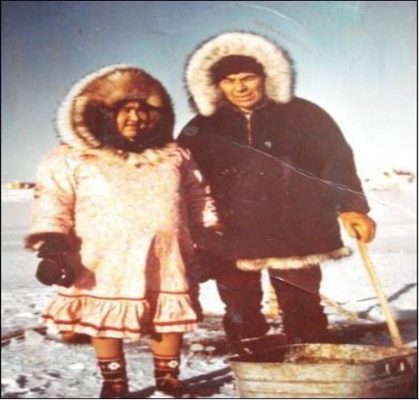
I was missing my ancestral homeland, community, and family and felt hopeless at times during the pandemic. I thought of my grandparents and knew that as young children they witnessed and survived disease epidemics approximately 100 years prior to us living in Covid times. Creating these masks was healing, inspiring many Inuvialuit to feel proud of who we are, sharing our history and story of survival, hence the name ‘Inuvialuit Fortitude.’
Cheryl Fennell (Snowfly)
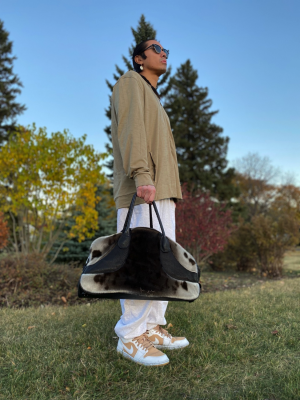
My favorite piece – I actually love my sealskin travel bag because I travel quite a bit and it not only holds what I need for my journey and reshapes itself under the seat but it ALWAYS draws rave comments. The first raver was a stewardess trying to corral a plane load of passengers in Toronto. She saw the bag and put her hand up and said loudly to which we all instantly, dutifully froze in our place: “Where did you get that BEAUTIFUL BAG!!! I have NEVER seen a more beautiful bag!!!!” I quietly said I designed it and her jaw opened as she speechlessly got back to managing the flow of plane passengers.
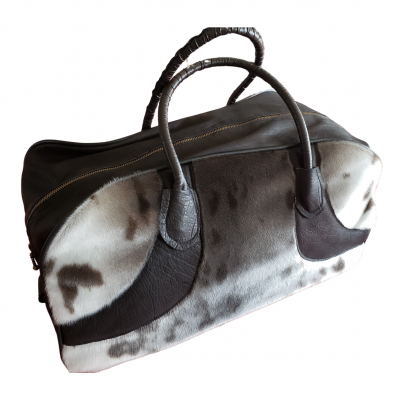
Harp Seal Fur Carrying Bag available at on www.proudlyindigenouscrafts.com
I was inspired to make the bags differently from your normal utilitarian bag a couple of years ago for Proudly Indigenous. I believe each bag is a piece of art and their design conveys an energy of honor and respect for the animals who gave their life for food.
April Allen (Stitched by April)
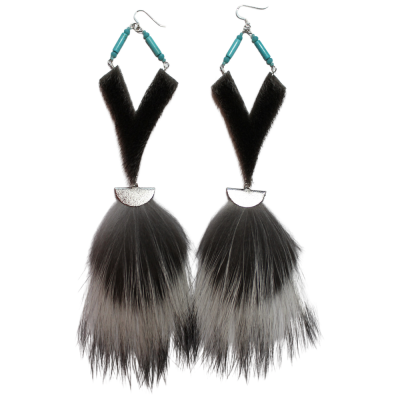
April’s Signature Seal & Fox Earrings available at www.proudlyindigenouscrafts.com
My favorite piece so far in my artistic career is my Signature earrings. In my ancestor’s time, these materials were used sustainably to provide warmth in the extreme cold and water barriers (we still use these materials today, for the same reasons). During the creation of these earrings, I could feel the energy of my ancestors radiating through me. I spent many hours working on the design and decided upon one that brought pride to me. The V shape sealskin resembles a tattoo, located on the forehead, which to me, signifies entering womanhood for us Inuit, while the silver fox fur adds a contemporary look that will leave one feeling timeless.
Creating each piece of art, especially this one, leaves me with feelings of love, excitement, honor, and pride.”
Bambi Amos (Bambi’s Traditional Arts)
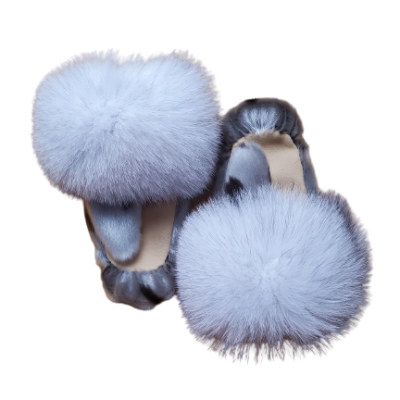
Ladies Seal Skin Boxer Style Mitts available on www.proudlyindigenouscrafts.com
My favorite piece I create is the boxer-style mittens. I feel so happy when creating them. I love thinking about the person I am making them for and how much they will love them too.
On this International Women’s Day we must remember to celebrate all forms of female creativity—including those expressed through art–and recognize the invaluable contributions made by Indigenous women artists working with seal skin across Canada’s northern regions. These talented individuals are keeping alive an ancient craft while simultaneously raising awareness about pressing environmental issues facing our planet today; something we can all learn from them! Let us not forget that there is power in preserving cultural heritage while also looking toward the future with hope and optimism!


